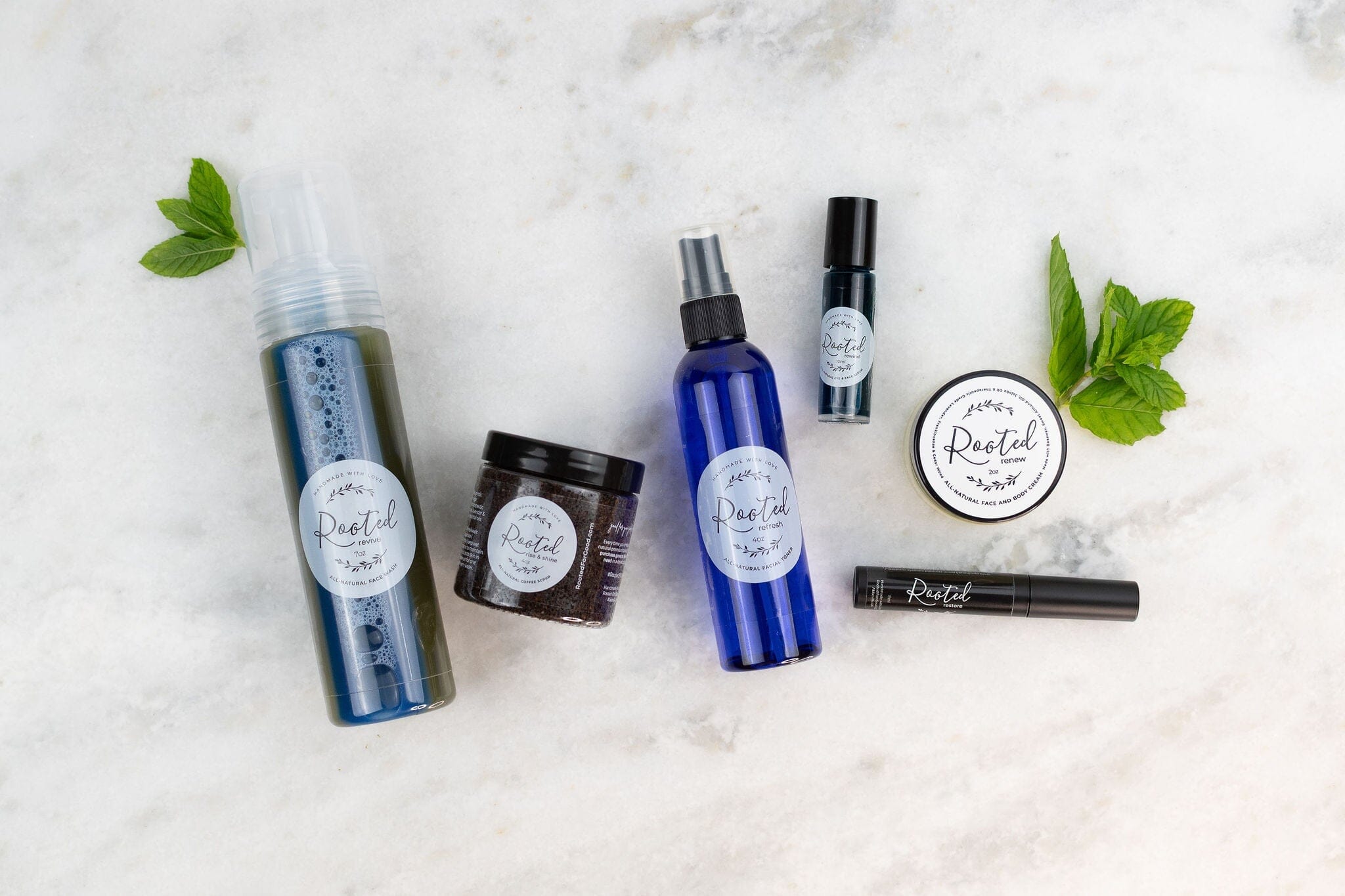Key Takeaways
- The author experienced common perimenopause symptoms such as hot flashes and mood swings.
- The author sought natural and simple menopause relief without synthetic ingredients.
- As a licensed cosmetologist and mother, the author values transparency in product labeling.
- The author is cautious about hidden toxins in menopause relief products.
Table of Contents
- Honest Question: Are You Searching for Simple, Natural Menopause Relief, But Unsure What's Really in the Bottle?
- Rooted For Good Philosophy, Supporting Real Beauty, Naturally
- What Happens During Menopause? Understanding Real-Life Symptoms
- Essential Oils for Menopause: How and Why They Work
- Key Natural Ingredients: The Best Essential Oils for Menopause Symptoms
- Real-World "How-To": Safe and Effective Ways to Use Essential Oils for Menopause
- Scientific Evidence: What Do Studies Really Say About Essential Oils for Menopause?
- Comparison Table: The Best Oils and Blends for Specific Menopause Complaints
- Troubleshooting & Sensitive Situations: What to Do If It's Not Working
- Creating Your Personalized Menopause Essential Oil Routine, And Sticking With It
Honest Question: Are You Searching for Simple, Natural Menopause Relief, But Unsure What's Really in the Bottle?
When my own body started changing during perimenopause, I found myself reading labels with new urgency. Hot flashes at 2am, mood swings that caught me off guard during family dinners, I wanted relief, but not at the cost of adding more synthetic ingredients to my routine. As a licensed cosmetologist and mom of six boys, I'd already learned that vague labels and hidden toxins weren't worth the risk.
Finding the right essential oil for menopause shouldn't feel like solving a puzzle. You deserve clarity about what you're putting on your skin and breathing in your home. Let's talk honestly about what works, what's safe, and what's worth your trust during this season of change.
If you're just starting your journey with natural solutions, a Single Essential Oils Starter Kit can be a simple way to explore which oils work best for your unique needs.
Rooted For Good Philosophy, Supporting Real Beauty, Naturally
Our mission began with a simple bucket-list challenge, use only natural products for our family of eight for three months. That challenge became Rooted For Good, a family-run company rooted in faith and committed to transparency. I create formulas with 100% natural ingredients and therapeutic-grade essential oils because I believe beauty already exists; skincare should support it, not mask it.
What makes Rooted For Good formulas different?
Simple, honest ingredients handcrafted for real life and real results. We include plant-based carrier oils and therapeutic-grade essential oils, never toxins, synthetic fragrances, or fillers. 10% of every sale supports transformation projects like clean water and housing, because care goes beyond skin.
When you're navigating menopause, you need products that work with your body's wisdom, not against it. Every essential oil for menopause in our collection is properly diluted and formulated for sensitive skin, because this season of life deserves gentle, effective support.
What Happens During Menopause? Understanding Real-Life Symptoms
Menopause officially begins 12 months after your last period, but perimenopause, the transition phase, can start years earlier. During this time, fluctuating hormone levels create a cascade of physical and emotional changes that affect every aspect of daily life.
The most common symptoms include hot flashes (experienced by 75% of women), night sweats that drench your sheets, sleep disruptions, mood swings, brain fog, and increased anxiety. You might also experience headaches, joint aches, and skin sensitivity that makes your usual products suddenly irritating.
| Symptom Category | Common Experiences | Body Systems Affected |
|---|---|---|
| Temperature Regulation | Hot flashes, night sweats, chills | Circulatory, nervous |
| Sleep & Energy | Insomnia, fatigue, restless nights | Nervous, endocrine |
| Emotional Balance | Mood swings, anxiety, irritability | Nervous, endocrine |
| Physical Comfort | Joint aches, headaches, skin changes | Musculoskeletal, integumentary |
Essential Oils for Menopause: How and Why They Work
Essential oils work through two primary pathways: aromatherapy affects your limbic system (the brain's emotional center), while topical application allows properly diluted oils to interact with your skin and underlying tissues. Research shows that certain essential oils can help regulate stress response and support emotional balance during hormonal transitions.
The "why" behind our approach centers on supporting your body's natural wisdom rather than masking symptoms. When you inhale lavender, for example, compounds like linalool and linalyl acetate can help activate your parasympathetic nervous system, promoting relaxation and better sleep quality.
Can essential oils really help with menopause symptoms?
Clinical studies show aromatherapy can reduce perceived severity of hot flashes by up to 50% and improve sleep quality scores. While essential oils work as a complement to medical care, never a replacement, they offer gentle, natural support for the emotional and physical challenges of menopause.
Each essential oil for menopause we recommend has been chosen for its specific therapeutic properties and safety profile. We're not looking for quick fixes, but rather sustainable support that honors this natural transition in your life.
Key Natural Ingredients: The Best Essential Oils for Menopause Symptoms
Clary Sage - Hormone-Supportive Balance
Best for: Hot flash relief and emotional balance
Clary sage contains natural esters that may help regulate cortisol levels and support hormonal balance. I've found it particularly effective when diffused during stressful moments or applied to pulse points before sleep. Its earthy, slightly floral scent provides grounding when emotions feel scattered.
Lavender - Calming Sleep Support
Best for: Sleep disruptions and stress relief
Lavender's linalool content makes it one of the most researched essential oils for sleep quality. When diffused 30 minutes before bedtime, it can help reduce the time it takes to fall asleep and improve deep sleep phases. I keep a lavender roller blend on my nightstand for those 2am wake-ups that leave your mind racing.
For more ways to use essential oils for overall wellness, you might enjoy these 3 essential oils for overall health and wellness.
Peppermint - Cooling Hot Flash Relief
Best for: Immediate cooling and head tension
The menthol in peppermint creates an instant cooling sensation that can provide relief during hot flashes. A few drops in a spray bottle with water creates a portable cooling mist. Always use properly diluted, peppermint is potent and can cause skin sensitivity if used undiluted.
Geranium - Emotional Balance
Best for: Mood swings and skin health
Geranium's rosy, balancing scent helps stabilize emotions during hormonal fluctuations. It's gentle enough for daily use and supports healthy skin during the dryness that often accompanies menopause. I blend it with plant-based carrier oils for a nourishing facial serum.
| Essential Oil | Primary Benefit | Best Application | Dilution Ratio |
|---|---|---|---|
| Clary Sage | Hormonal balance, hot flash relief | Diffusion, pulse points | 6 drops per 1 oz carrier oil |
| Lavender | Sleep quality, anxiety relief | Bedtime diffusion, bath | 8 drops per 1 oz carrier oil |
| Peppermint | Cooling, headache relief | Cooling spray, temples | 3 drops per 1 oz carrier oil |
| Geranium | Emotional balance, skin support | Facial blend, diffusion | 6 drops per 1 oz carrier oil |
If I wouldn't put an ingredient on my own skin during this vulnerable time, I won't recommend it to you. Every essential oil for menopause we suggest is free from synthetic fragrances, toxins, and unnecessary fillers that can irritate already-sensitive skin.
Real-World "How-To": Safe and Effective Ways to Use Essential Oils for Menopause
Hot Flash Cooling Spray
Mix 3 drops peppermint and 2 drops lavender in a 2-ounce spray bottle with distilled water. Shake before each use and mist your face, neck, and wrists when you feel a hot flash beginning. Keep one in your purse and one on your nightstand.
Night Sweat Diffuser Routine
Start your diffuser 30 minutes before bedtime with 3 drops clary sage and 4 drops lavender. This creates a calming environment that supports better sleep quality and may reduce the frequency of night sweats. Run for 2-3 hours maximum to avoid scent overload.
Anxiety Relief Pulse Point Blend
Combine 6 drops geranium with 1 ounce jojoba oil in a roller bottle. Apply to wrists and behind ears when you feel anxiety building. The act of applying becomes a mindful moment that enhances the oil's calming effects.
Safety First: Proper Dilution Guidelines
Always dilute essential oils before skin contact. For face: 3-6 drops per ounce of plant-based carrier oil. For body: 6-12 drops per ounce. Never use undiluted oils, and always patch test new blends on your inner wrist first.
These routines fit into real life, no complicated steps or hard-to-find ingredients. Each method respects that you're busy while honoring your need for gentle, effective support during menopause.
For more targeted support, see our guide on essential oil for sleep to help with restlessness and nighttime disruptions.
Scientific Evidence: What Do Studies Really Say About Essential Oils for Menopause?
Clinical research on essential oil for menopause shows promising results for symptom management. A 2016 study of 100 women found that aromatherapy massage with clary sage reduced hot flash severity by 44% over 8 weeks. Another study demonstrated that lavender aromatherapy improved sleep quality scores by 23% in postmenopausal women.
The evidence is strongest for mood support and sleep improvement. Research consistently shows that inhaling certain essential oils activates the parasympathetic nervous system, reducing cortisol levels and promoting relaxation. However, larger, longer-term studies are still needed to fully understand the mechanisms. For a deeper dive into the science, see this clinical research summary on essential oils for menopause.
What's important to understand: essential oils work as complementary support, not medical treatment. They can significantly improve quality of life and help you feel more balanced during this transition, but always consult your healthcare provider for persistent or severe symptoms.
Comparison Table: The Best Oils and Blends for Specific Menopause Complaints
Choosing the right essential oil for menopause depends on your primary symptoms and lifestyle. Here's how the most effective oils stack up for specific needs:
| Essential Oil | Best For | Application Method | Time to Effect | Sensitivity Level |
|---|---|---|---|---|
| Clary Sage | Hot flashes, hormonal balance | Topical (properly diluted) | 15-30 minutes | Gentle for most skin types |
| Lavender | Sleep disruption, anxiety | Diffusion or pillow spray | 10-20 minutes | Universally well-tolerated |
| Peppermint | Immediate cooling, brain fog | Cooling spray or inhaler | 1-5 minutes | Use properly diluted; can irritate |
| Geranium | Mood swings, skin changes | Bath blend or face serum | 20-45 minutes | Gentle, suitable for daily use |
Single oils offer targeted relief, while blended formulas provide comprehensive support. For sensitive skin or strong scent sensitivity, start with lavender or geranium, they're the gentlest entry points.
The key difference in our approach: every formula uses plant-based carrier oils for proper dilution, never synthetic fragrances or fillers that can trigger additional symptoms. For more on natural solutions, you might also like our article on essential oil for cough.
Troubleshooting & Sensitive Situations: What to Do If It's Not Working
When essential oils aren't providing the relief you expected, small adjustments often make the difference. Here are the most common issues and their solutions:
Skin irritation or redness: You're likely using too high a concentration. Reduce to 6 drops per ounce of plant-based carrier oil instead of 12. Switch to gentler oils like lavender or geranium, and always patch test on your inner wrist first.
Headaches from scents: Start with single drops instead of the full recommended amount. Ensure proper ventilation when diffusing, and try blends rather than single oils, they're often less overwhelming.
No symptom improvement after two weeks: Consider whether you're addressing the right symptoms with the right oils. Hot flashes need cooling oils like peppermint, while sleep issues respond better to lavender or clary sage. Match the oil to your primary concern.
Symptoms worsen or new ones appear: Stop use immediately and consult your healthcare provider. Some people experience sensitivity to specific botanical families, and that's completely normal.
For those on hormone therapy or medications, always discuss essential oil use with your doctor first. While topical application is generally safe, individual responses vary. For additional scientific perspective, see this peer-reviewed article on aromatherapy and menopause.
Remember: real beauty is listening to your body's wisdom. If something doesn't feel right, trust that instinct and adjust accordingly.
Creating Your Personalized Menopause Essential Oil Routine, And Sticking With It
Building a sustainable routine starts with identifying your top three menopause symptoms. Hot flashes and sleep disruption? Begin with a cooling peppermint spray for daytime and lavender diffusion at bedtime. Mood swings and anxiety? Try geranium in your morning routine and clary sage in the evening. Keep your routine simple and consistent, real results come from small, daily steps that fit your real life.
Remember, every formula I create is handcrafted with 100% natural ingredients and therapeutic-grade essential oils, no toxins, no fillers. Honest labels, full transparency. Made for real life, and gentle enough for sensitive skin.
10% of every sale supports transformation projects, clean water, housing, and opportunity for families in need. Goodness. Truth. Real Beauty. I’m so glad you’re here. If you’re ready to start a simple, natural routine, explore the collection and join our community.
Frequently Asked Questions
How do essential oils like clary sage, lavender, and peppermint help alleviate menopause symptoms such as hot flashes and mood swings?
Essential oils like clary sage, lavender, and peppermint can help ease menopause symptoms by promoting relaxation and balancing mood. Clary sage is known for its calming effects, lavender supports restful sleep and reduces stress, and peppermint provides a cooling sensation that can soothe hot flashes when properly diluted.
What should I look for on product labels to ensure my menopause relief products are free from hidden toxins and synthetic ingredients?
Look for clear, honest labels that list simple, recognizable ingredients without vague terms or fillers. Choose products handcrafted with 100% natural ingredients and therapeutic-grade essential oils, and avoid those containing synthetic fragrances, parabens, phthalates, or other common toxins.
How can I safely use essential oils for menopause relief, especially if I have sensitive skin?
Always use essential oils properly diluted with plant-based carrier oils to avoid irritation, especially on sensitive skin. Start with small amounts, perform a patch test, and apply to pulse points or diffuse in the air rather than applying undiluted directly to skin.
What scientific evidence supports the effectiveness of essential oils in managing menopause symptoms?
Studies suggest that certain essential oils like clary sage and lavender may help reduce hot flashes, improve mood, and promote relaxation during menopause. While more research is ongoing, many women find these natural options supportive when used safely as part of a balanced routine.





